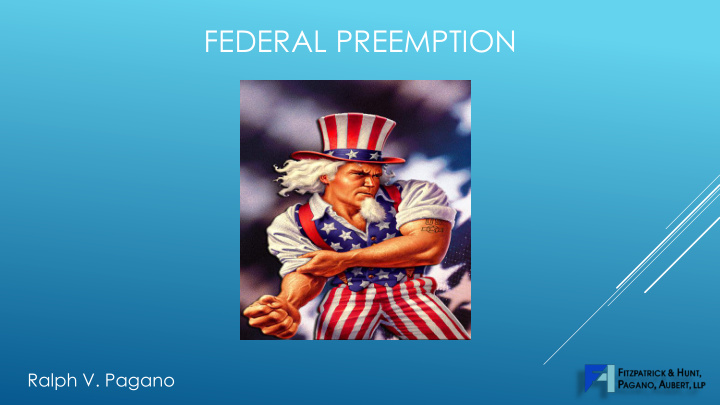



FEDERAL PREEMPTION Ralph V. Pagano
WHAT IS PREEMPTION ? • The U.S. Constitution allows federal laws enacted by Congress to preempt state law • A Federal law can either explicitly preempt state law claims or it can be done by implication
WHAT IS PREEMPTION ? • To be “implied” Congress must show an intent to fully occupy the field at issue or the federal law must conflict with state law such that it is impossible to comply with both
ARE STATE LAW CLAIMS PREEMPTED BY THE FEDERAL AVIATION ACT ? Sikkelee v. Precision Airmotive : Pilot fatally injured when the carburetor in his Cessna 172 allegedly malfunctioned causing the airplane to crash. Plaintiff’s claims were ultimately narrowed to design defect and failure to warn. District Court held that design defect claims were preempted but failure to warn claims were not. Sikkelee v. Precision Airmotive, 2016 , Third Circuit Court of Appeals held that state law products liability claims for design defects are not field preempted. Thus, the Third Circuit says “No”.
NO FIELD PREEMPTION, BUT PERHAPS CONFLICT PREEMPTION • In its Opinion, the Third Circuit Court acknowledged that these claims may be subject to conflict preemption – there may be circumstances in which it is impossible for a manufacturer to comply with both federal and state law • Manufacturers cannot make major changes to the design of their products without FAA approval
CONSIDERING CONFLICT PREEMPTION • The lower court, in its 115 page Decision considered whether the state tort claims were conflict preempted • The conflict preemption analysis begins by analyzing state and Federal law
CONFLICT PREEMPTION – STATE LAW • Under Pennsylvania tort law, the manufacturer has a duty to make . . . the product . . . free from a defective condition unreasonably dangerous to the consumer
CONFLICT PREEMPTION – FEDERAL LAW • Under Federal law governing the design and manufacture of aircraft components, FAA approval is required for any major or minor changes to an article’s type design, as well as for any major alteration. • A major alteration is one that might appreciably affect airworthiness such as weight, balance, structural strength, performance, powerplant operation, and flight characteristics
THE DECISION ON CONFLICT PREEMPTION • The District Court reasoned that because the engine manufacturer could not have independently made any changes to the engine without first obtaining FAA approval, the state law tort claim for design defect is clearly conflict preempted by federal law. • The critical inquiry is whether a regulated party can unilaterally comply with both regimes simultaneously. Where one cannot, concepts of supremacy clarify that the state law has no force.
RESPONSE BY THE PLAINTIFF’S BAR • Certification = no liability for manufacturers • That would be true for design defect claims and logical because of the extensive certification process, but manufacturing defect, and possibly failure to warn claims can still exist. • The Aviation Regulations promulgate “minimum standards” • The Court addressed this by saying that minimum standards in life-or-death fields such as aviation or pharmaceuticals are set substantially higher. • State law remedial measures would have already been demanded by the FAA • Designated Engineering Representatives (DERs) are merely shills for the company seeking certification. • The DER is an independent contractor of the FAA and serves as a functional extension of the FAA, working to make the FAA approval process more efficient, not to lower the applicable regulatory standards
NEXT STEPS • We have not heard the last of this case, as it would appear that an additional appeal will be taken • Stay tuned!
Post-Sale Duty to Warn Garth W. Aubert, Esq. 12
Types of Warnings Point-of-Sale Duty to Warn: • A duty to provide consumers with warnings of those dangers that the manufacturer knows or should know at time of sale • Labels • Manuals Post-Sale Duty to Warn: • A duty to provide consumers with warning of dangers a manufacturer discovers or should have discovered after sale • Manufacturer/Seller of product is subject to liability for harm to persons or property caused by the failure to warn after the sale when a reasonable person in the seller’s position would provide such a warning
What is “Reasonable”? (When is a Post-Sale Warning required?) 1. Seller knows or reasonably should know the product poses substantial risk of harm to persons or property • Improvements in state of the art Previously unexpected misuse • 2. Users can be identified and reasonably assumed to be unaware of risk 3. Warning can be effectively communicated & acted upon by users 4. Risk of harm is sufficiently great to justify the burden of providing a warning Frequency • Severity •
When is a Post-Sale Warning Required? “It depends” • • Fact driven inquiry, dependent on circumstances Law varies by state - most states impose continuing • duty to warn Determined by a jury •
Duty to Recall Liability for failure to recall if: • Required by statute or governmental regulation; or • In absence of recall requirement, the seller undertakes to recall the product and does so negligently • Common law duty to recall/retrofit is very limited
Post-Sale Action Plan 1. Safety first 2. Plan ahead – Product Safety Committee 3. Review information received from the field & act on it 4. Establish lines of communication 5. Ensure a consistent message 6. Get advice!
Resources • ABC Law Report article by Suzanne McNulty • Product Integrity Seminars by F ITZ H UNT through the ABC Program
Recommend
More recommend